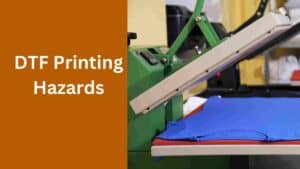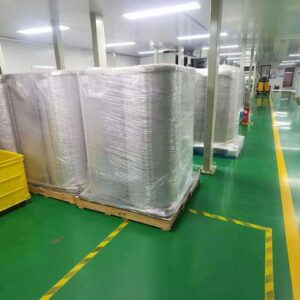DTF printing produces high-quality prints on textiles, ceramics, and plastics quickly and affordably. But this is the question I frequently encounter: is DTF printing toxic? Nonetheless, there are worries regarding the possible toxicity of DTF printing, which may pose health hazards to consumers. To encourage safe usage of DTF printers and materials, it is essential to investigate and prevent health concerns. We’ll cover these concerns and how to minimize them with safe and appropriate DTF printer and material usage in this post.

Is DTF Printing Toxic?
If handled improperly, DTF printing materials may be harmful. DTF printing ink and transfer films may include volatile organic compounds (VOCs), plasticizers, and solvents. They can harm the respiratory system, skin, and eyes if handled improperly. Protective gear and working in a well-ventilated location may reduce these dangers. To minimize any possible health concerns, it is crucial that users utilize these products properly and adopt the required safety procedures.
Do DTF printers give off toxic fumes?
Volatile organic compounds (VOCs) from DTF printers may be dangerous if breathed in significant amounts. VOCs evaporate at room temperature and cause respiratory discomfort and other health issues. DTF printers generate VOCs depending on the printer and materials.
Understanding the Risks
Materials Used in DTF Printing
DTF printing produces high-quality prints on a variety of surfaces by combining specialized ink and transfer films. The ink we use in DTF printing is commonly a pigment-based or dye-based ink. This can be water-based or solvent-based. Often comprised of polyester or polyurethane, transfer films are used in DTF printing and available in a range of textures, including matte, gloss, and metallic.
While the materials used in DTF printing are typically harmless, some of the compounds used in the ink and transfer films have the potential to be harmful. For instance, certain inks made with solvents may include volatile organic compounds (VOCs). When you breathe, they are dangerous to human health. Transfer films also contain harmful substances like plasticizers.
Using ink and transfer films that are approved for use in DTF printing will help to reduce these risks. Use DTF printers in well-ventilated environments and use gloves and masks while handling ink and transfer films. By knowing DTF printing materials and dangers, practitioners can reduce exposure and encourage safe and responsible usage.
Potential Health Risks Associated with DTF Printing Materials
DTF printing’s ink and transfer films might harm people if not handled appropriately. Chemicals like VOCs and plasticizers that are present in the ink and transfer films are responsible for these dangers.
Respiratory issues are one of the main health hazards that relates to DTF printing. Inhaling VOCs or other compounds in ink or transfer films may induce coughing, wheezing, and breathing problems. Asthma and chronic bronchitis are two more serious respiratory disorders that may develop as a consequence of prolonged exposure to these substances.

DTF printing may irritate skin. Some of the compounds in the ink or transfer films have the potential to irritate the skin. This results in redness, itching, or rashes in certain cases. Handling these compounds without gloves or other protection is very risky.
Another possible health issue associated with DTF printing is eye discomfort. Ink or transfer film exposure may irritate the eyes, resulting in redness, itching, and a burning feeling. Prolonged exposure may sometimes cause more serious eye diseases, such conjunctivitis or corneal damage.
Factors Influencing the Toxicity of DTF Printing
How toxic are DTF printers? DTF printing materials’ toxicity depends on ink and substrate. People should make well-informed choices regarding the materials they use. Also, they should know how to handle them safely.
Ink: The kind of ink used in DTF printing has an effect on its toxicity. Inhaling VOCs from solvent-based inks may be dangerous. Water-based inks are safer, although they may include minute quantities of chemicals that might irritate skin or eyes. Ink that has been approved for use in DTF printing must be chosen carefully and handled.
Substrate: The substance or substrate on which we print the ink can be harmful. Certain textiles contain chemicals or colors that react with ink, releasing poisonous fumes. Moreover, challenging-to-print-on materials could need more ink or a higher temperature, which raises the chance of chemical exposure.
Printer: DTF printing’s toxicity depends on the printer and equipment used. Equipment that we don’t maintain properly or isn’t working properly create more heat or fumes. These fumes raises the possibility that toxic substances will be exposed. To reduce hazards, follow manufacturer directions for operating and maintaining DTF printers and equipment.
These considerations help consumers choose materials and use them safely. To encourage safe and responsible usage, it’s also critical to keep informed of the most recent findings and suggestions on DTF printing safety.
What type of ink is used in DTF printing?

The ink used in DTF printing is commonly referred to as “DTF ink.” This is a unique kind of ink made to stick to the transfer film used in the DTF printing process. Water-based pigment ink is durable and produces brilliant, long-lasting colors.
Plasticizers and solvents may enhance DTF ink adherence. To reduce any possible health dangers, it’s crucial to use the right kind of ink for your DTF printer and handle it carefully.
Is DTF printing eco friendly?
DTF printing uses less water and energy than several other printing techniques, including screen printing and sublimation printing, making it more environmentally friendly. DTF printing consumes less water and energy since the ink is directly printed onto the transfer film.
Moreover, certain DTF transfer films are created from biodegradable components, which might lessen waste and the negative effects of printing on the environment.
So, Is DTF good for the environment? Nonetheless, DTF printing still uses inks and other components that might affect the environment if not handled appropriately. Thus, it is crucial for users to properly dispose of DTF printing waste and to take action to reduce any possible environmental effects.
Is DTF Toxic to run from home?

If the right personal protective equipment (PPE) and fume management systems are in place, you can run DTF printing operation safely from home. ( with only a small chance of expose to harmful materials).
Gloves, masks, and fume management systems like exhaust fans and air purifiers may protect the skin and respiratory system from chemicals and fumes.
To reduce environmental effect, observe all DTF printer and material safety rules and appropriately dispose of waste. By taking these steps and buying the right tools, you can run a safe and successful DTF printing business from your home.
Is DTF safe for kid products?
DTF printing is safe for child items if you use the right materials and follow safety rules. Certain DTF inks and transfer films may include dangerous substances that might be toxic if consumed or absorbed via the skin, such as lead or phthalates.
Use DTF inks and transfer films approved for use with children’s items and follow manufacturer safety requirements to ensure kid product safety. To eliminate chemicals and odors, you should wash & dry DTF printed textiles before use. DTF printing can generate colorful, long-lasting child goods with these safeguards.
Conclusion | DTF Printing Toxiticity
While being a very well and efficient printing technique, DTF printing is not without possible health concerns. Unhandled DTF printing materials may harm the respiratory system, skin, and eyes. Yet, safety recommendations may reduce these dangers, according to study. We need further study to properly understand DTF printing’s health and environmental effects. Users must be cautious and take measures while dealing with DTF printing materials.
FAQs
DTF printing at home is safe if you follow safety rules and utilize PPE and fume control solutions.
DTF printing may affect your health if not done safely. To reduce possible dangers, it’s critical to utilize the right materials and adhere to safety precautions.
Biodegradable inks and recyclable transfer films are eco-friendly DTF printing choices.
DTF printing can make kid-friendly items, but it’s crucial to use DTF inks and transfer films that are certified safe for children’s products.
DTF printing requires less water, energy, and waste than screen printing or direct-to-garment printing, making it safer and more ecologically friendly. However, it is still important to take proper safety precautions and use eco-friendly materials.

Ashley Wang is a skilled sales manager with knowledge in DTF printing. She presently works for ShenLan Digital, a reputable DTF printer maker. Ashley is the best person to offer advice on selecting the most suitable DTF printer because she has tested a lot of them. She launched DTFPrinterSchool to educate individuals and organizations about DTF printing technology, providing her expertise and observations on the most recent advancements in the sector. Ashley is an invaluable resource for businesses and individuals wishing to invest in DTF printing technology because of her expertise and experience in the industry.
